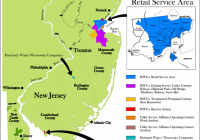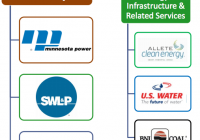Dividend Growth Stock Overview: Middlesex Water Company
Summary MSEX provides water and wastewater services to about 450,000 people across New Jersey, Delaware and Pennsylvania. The company has paid dividends since 1912 and increased them since 1973. MSEX has compounded dividends at less than 1.5% for the last decade and less than 2% for the last quarter century. About Middlesex Water Company Middlesex Water Company (NASDAQ: MSEX ) provides water and wastewater services to over 450,000 people across parts of New Jersey, Delaware and Pennsylvania. The company began operating water utility services in New Jersey in 1897, and recently expanded to Delaware in 1992 and Pennsylvania in 2009. The company also received approval to operate in Maryland in 2007, but does not have any business there. Image from Middlesex Water Company’s website . Middlesex Water divides its operations into two business segments – regulated and unregulated. Like most utilities, the company receives most of its revenue and income from its regulated business, providing an average of 88% and 93% of revenues and income from 2012-2014. In 2014, Middlesex’s regulated businesses had revenues of $103.3 million, up 2.6% from 2013, and net income of $17.3 million, up 11.6%. The increase in revenues was due to higher customer demand and rate increases from regulatory agencies. The large net income increase was due to lower expenses from improved performance in the company’s pension plan and fewer water main breaks as compared to 2013. The unregulated business segment – covering Middlesex’s service in Perth Amboy, NJ; Avalon, NJ; and portions of Delaware – had net income of $1.2 million on revenues of $13.8 million, up 9.1% and down 2.1%, respectively. In 2014, Middlesex Water had total revenues of $117.1 million, of which nearly half came from residential customers. The company’s net income was up nearly 11% year-over-year to $18.4 million and EPS were up 9.7% to $1.13. With the annualized dividend payment of 77 cents per share, Middlesex Water has a payout ratio of about 68%. The company trades under the ticker symbol MSEX. Middlesex Water Company’s Dividend and Stock Split History Middlesex Water has grown dividends incredibly slowly – less than 1.5% a year for the last decade. Middlesex Water has paid dividends continuously since 1912 and increased them annually since 1973. The company pays out its quarterly dividends at the beginning of March, June, September, and December. Annual dividend increases are announced around the 20th of October, with the stock going ex-dividend in mid-November. Last November, Middlesex Water announced a 1.3% increase in the quarterly dividend to an annualized payment of 77 cents per share. Middlesex Water should announce its 43rd annual dividend increase in October 2015. Middlesex Water has built a record of steady, but very slow dividend growth. Since 2004, the company has increased its annual dividend by a penny a year, resulting in 5- and 10-year compounded annual dividend growth rates (CADGRs) of 1.4%. Longer term, the dividend growth record is not much better; the 20-year and 25-year CADGRs are 1.9% and 2.0%, respectively. The company has split its stock 4 times since beginning its record of annual dividend growth. 2-for-1 splits occurred in December 1984 and September 1992; a 3-for-2 split occurred in January 2002; and a 4-for-3 split occurred in November 2003. Prior to 1973, Middlesex Water split its stock 5-for-1 in October 1927; 3-for-2 in October 1959; and 2-for-1 in December 1967. A single share of Middlesex Water’s stock purchased in 1973 would have split into 8 shares. Over the 5 years ending on December 31, 2014, Middlesex Water’s stock appreciated at an annualized rate of 9.52%, from a split-adjusted $14.39 to $22.67. This underperformed the 13.0% annualized return of the S&P 500 during this time. Middlesex Water Company’s Direct Purchase and Dividend Reinvestment Plans Middlesex Water Company has both direct purchase and dividend reinvestment plans. You do not need to be a current investor to participate. New investors must purchase at least $500 of Middlesex Water’s stock and are required to reinvest dividends on at least 10 shares of stock. Subsequent purchases of stock must be at least $25. The fee structure of the plan is favorable for investors, with the company picking up all fees on stock purchases. When you sell your shares, you’ll pay a sales commission of $15 plus associated brokerage fees. All fees are deducted from the sales proceeds. Helpful Links Middlesex Water Company’s Investor Relations Website Current quote and financial summary for Middlesex Water Company (finviz.com) Information on the direct purchase and dividend reinvestment plans for Middlesex Water Disclosure: I/we have no positions in any stocks mentioned, and no plans to initiate any positions within the next 72 hours. (More…) I wrote this article myself, and it expresses my own opinions. I am not receiving compensation for it. I have no business relationship with any company whose stock is mentioned in this article.

